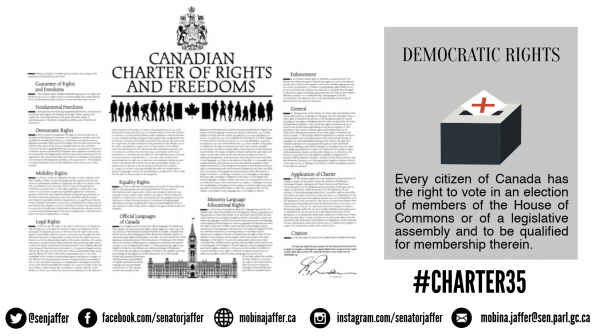
Starting this week, this blog series will be moving on to a new set of rights under the Canadian Charter of Rights and Freedoms: The democratic rights under Sections 3 to 5! This week, I will provide a general overview of these democratic rights, which will act as context for the next entries in the weeks to come.
When Canada first came into being in 1867, the right to vote was not absolute.
This resulted in practices that made Canada an undemocratic country in the first days of the constitution: for example, oral votes were common practice, leaving people open to intimidation, and governments often refused to hold elections in ridings where they knew that they risked losing seats.
Many laws were also passed to restrict the vote. For example, from 1885, only people with property of values set by the provinces had the right to vote, barring less wealthy Canadians. Further, women were denied the right to vote until 1919, since they were not recognized as “persons” under the law!
However, out of all Canadians, none were more targeted than Asian Canadians. For example, the 1885 Electoral Franchise Act explicitly prohibited Chinese Canadians from participating in any elections.
Provincial laws also denied many Canadians the franchise- for example; British Columbia had banned Chinese Canadians from voting almost immediately after confederation! In the next 40 years, Japanese, South Asian and Sikh Canadians would all be added to that prohibition.
Recognizing this questionable history, Sections 3 through 5 of the Charter set out provisions to prevent these kinds of laws from ever existing again:
Section 3 of the Charter states that-
- Every citizen of Canada has the right to vote in an election of the members of the House of Commons or of a legislative assembly and to be qualified for membership therein.
In other words, laws such as those that prohibit people from voting based on their gender, race or wealth are unconstitutional. Further, Section 3 grants all Canadians the right to run for membership in the House of Commons, or any provincial legislative assembly.
Section 4 of the Charter states that-
- (1) No House of Commons and no legislative assembly shall continue for longer than five years from the date fixed for the return of the writs at a general election of its members.
(2) In time of real or apprehended war, invasion or insurrection, a House of Commons may be continued by Parliament and a legislative assembly may be continued by the legislature beyond five years if such continuation is not opposed by the votes of more than one-third of the members of the House of Commons or the legislative assembly, as the case may be.
In other words, federal elections must take place from time to time, preventing practices where governments refuse to hold elections in ridings they might lose. If there is no ongoing war or rebellion, Canada and its provinces must hold elections at least once every five years.
Finally, Section 5 of the Charter states that:
- There shall be a sitting of Parliament and of each legislature at least once every twelve months.
This section was passed because of a single principle: Parliament and the legislative assemblies must be answerable to its opposition and the public, both through debate and through Question Period.
The democratic rights found in Sections 3 to 5 of the Charter all hold a common logic- each of them prohibits harmful practices that had previously made Canada undemocratic. Without them, many of the most vulnerable groups in Canada would still not have the vote!
Please check in over the weeks to come, as I provide a more in-depth look into the history of how these sections of the Charter were influenced by Canada’s history of electoral exclusion.